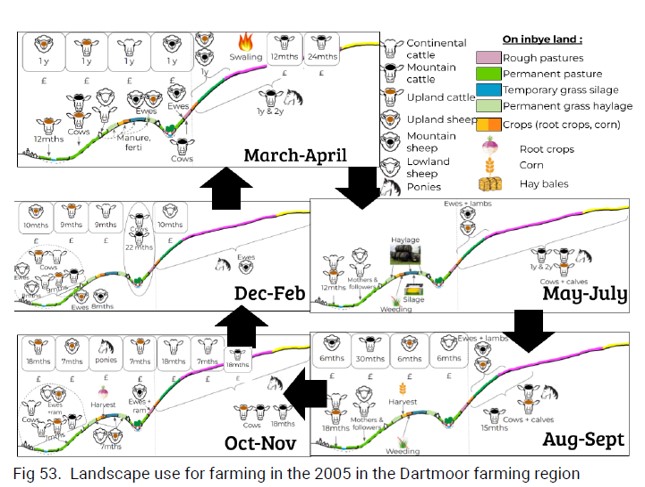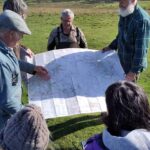We will implement the project through six work packages.
WP1 – Satoyama Integrated Landscape Appraisal (SILA)
This entails applying a detailed, integrated assessment of each case study area, considering social, ecological and economic (SEE) characteristics and their interlinkages, and examining how these have changed in response to external SEE drivers and trends. The work package will make a holistic appraisal of each socio-ecological production landscape in our 6 case study areas, combining natural science, economic and social science methods, giving a baseline for monitoring system change over the research period.

A diagram of farming systems evolution in Dartmoor – from the agrarian diagnosis method that Satoconn is adapting for its SILA.(Lucie DUVERNE and Paul PAGES, 2023)
WP2 – Living Labs coordination, facilitation and support
This work package will engage local communities in each living lab to:
- identify climate and biodiversity challenges and opportunities, and
- explore how to address and resolve these, with social science, research and economic expertise contributed by the research partners through WP3.
Respecting and adapting to local culture and custom, we will apply a range of traditional and novel participatory approaches to facilitate engagement, including arts and creative practice approaches. Crucially, we will foster development of appropriate endogenous governance structures and develop linking social capital with exogenous institutions, which will enable sustained positive change beyond the life of the project.
WP3 – Analysis of drivers and solutions
This work package will focus on analysing methods to address the climate and biodiversity challenges at a pragmatic level, as best suited to each LL situation, helping communities to develop practical solutions with generalizable and transferable relevance. It will co-develop the tools for evaluation and identification of future options for transformation that are then mobilized through the LLs using facilitation and engagement (as overseen by the WP2 leads), and will gather the experiences that flow back from the process of LL testing and learning, within a coherent evaluation framework capable of generating broad lessons of wider resonance and general applicability. The framework will combine elements of SWOT analysis with new conceptual ideas in SES dynamic assessment (e.g. Andrachuk and Armitage, 2015), developed in the inception phase of the project, then agreed and implemented through the 6 LLs as they undertake their WP2 cycle of activities.
In this way WP3 will generate new information and learning with common value and meaning, across the full diversity of LL situations.
WP4 – Synthesis and evaluation
This work package will build on the work in WP3 to analyse drivers and solutions, by collating and synthesizing the findings from each Lab into a coherent whole. Using multi-disciplinary comparative analysis and learning by exchange in a community of practice, a series of overarching lessons and recommendations will be identified for increased resilience in Satoyama and SEPLs. These will be explored via a series of structured reports, academic articles, conference attendances and visual and social media networking.
A key element of this work package will be to present, share and refine good practice among the living lab communities locally and with a wider range of relevant stakeholders within the region. In addition, emerging findings from comparative analysis will be ground-truthed and peer-reviewed by a panel of experienced applied researchers and policy developers from Europe and Japan, including 2 RIHN senior researchers working in other research programs, to strengthen communication across the Institute.
WP5 – Communication, dissemination and exploitation: Achieving Impact
This work package will focus on national and international partnering and dissemination of results among the broader research and policy communities. Initial steps will be:
- to design, host and regularly populate a dedicated website and social media presence, to build a community of interested partners and followers;
- to establish a project board with known representatives of key international organisations including IUUCN, IPSI, IASC, IFPRI and OECD, to provide advice and guidance throughout.
WP5 will produce briefings and a newsletter to track progress and illustrate key features of the LLs and their challenges. It will also disseminate and extend its synthesis and evaluation through workshops, publications and field events. A final project conference will be held (in Japan) in early 2028, presenting clear recommendations for policy, practice and science.
WP6 – Management and coordination
Led by the PI and supported by a core team (administrator, research associate and senior researcher) based at RIHN in Kyoto, Japan, with special coordination support for European partners by a sub-lead and administrator at the University of Gloucestershire, UK (with whom a MOU is established).
This WP will oversee project progress, manage the peer review group and advisory board, produce project reports (inception, mid-term and final) and take charge of budgeting and arranging all project meetings for training, planning, marking progress and enabling exchange between partners at international level.
This will also be the main team in charge of liaison with other personnel and teams in RIHN.



